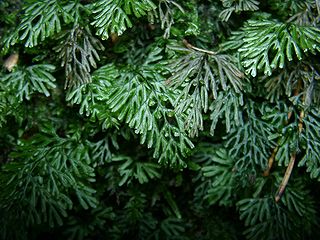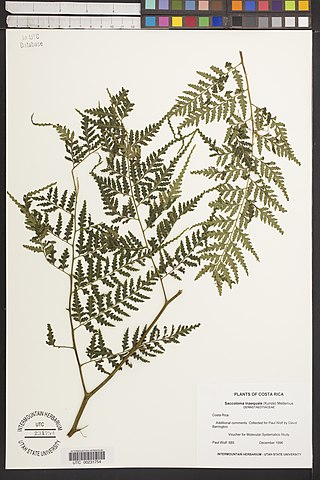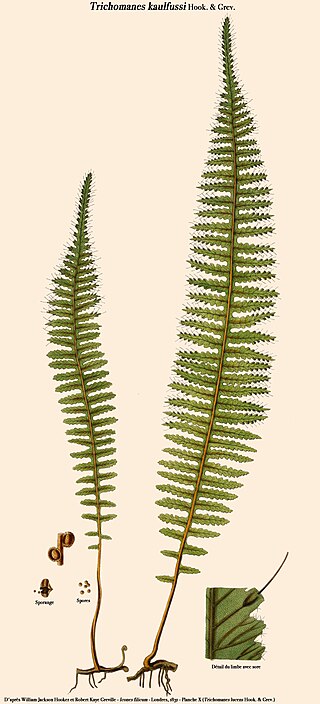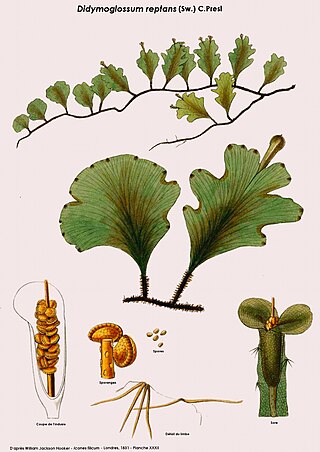
Thelypteridaceae is a family of about 900 species of ferns in the order Polypodiales. In the Pteridophyte Phylogeny Group classification of 2016, it is placed in the suborder Aspleniineae. Alternatively, the family may be submerged in a very broadly defined family Aspleniaceae as the subfamily Thelypteridoideae.

The Hymenophyllaceae, the filmy ferns and bristle ferns, are a family of two to nine genera and about 650 known species of ferns, with a subcosmopolitan distribution, but generally restricted to very damp places or to locations where they are wetted by spray from waterfalls or springs. A recent fossil find shows that ferns of Hymenophyllaceae have existed since at least the Upper Triassic.

Hymenophyllum is a genus of ferns in the family Hymenophyllaceae. Its name means "membranous leaf", referring to the very thin translucent tissue of the fronds, which gives rise to the common name filmy fern for this and other thin-leaved ferns. The leaves are generally only one cell thick and lack stomata, making them vulnerable to desiccation. Consequently, they are found only in very humid areas, such as in moist forests and among sheltered rocks. They are small and easy to overlook.

Saccoloma is a fern genus in family Saccolomataceae. It is the only genus in the family in the Pteridophyte Phylogeny Group classification of 2016, but further investigation is needed. It is pantropical and its species are found in wet, shaded forest areas. Saccoloma species are characterized by an omega-shaped (Ω) vascular bundle in the cross-sections of their petioles. The common name soralpouch fern is used for Saccoloma.

Polyphlebium angustatum is a species of fern in the family Hymenophyllaceae. It is found in South America and on a number of Atlantic islands, including Tristan da Cunha. The genus Polyphlebium is accepted in the Pteridophyte Phylogeny Group classification of 2016 (PPG I), but not by other sources. As of October 2019, Plants of the World Online sank the genus into a broadly defined Trichomanes, treating this species as Trichomanes angustatum.

Trichomanes is a genus of ferns in the family Hymenophyllaceae, termed bristle ferns. The circumscription of the genus is disputed. All ferns in the genus are filmy ferns, with leaf tissue typically 2 cells thick. This thinness generally necessitates a permanently humid habitat, and makes the fronds somewhat translucent. Because of this membrane-like frond tissue, the plant is prone to drying out. “Filmy ferns” in the taxa Hymenophyllaceae grow in constantly wet environments. Many are found in cloud forests such as “Choco” in Colombia. There are also members of the taxa that can grow submersed in water.
Polyphlebium tenuissimum, synonym Trichomanes tenuissimum, is a species of fern in the family Hymenophyllaceae. It is endemic to Ecuador. In 2006, in a taxonomic revision of the family Hymenophyllaceae, Ebihara et al. assigned this species to the genus Polyphlebium rather than Trichomanes. However the combination does not appear to have been formally published; hence the "comb. ined." in the Checklist of Ferns and Lycophytes of the World.

Tectariaceae is a family of leptosporangiate ferns in the order Polypodiales. In the Pteridophyte Phylogeny Group classification of 2016 (PPG I), the family is placed in the suborder Polypodiineae. Alternatively, it may be treated as the subfamily Tectarioideae of a very broadly defined family Polypodiaceae sensu lato. The family comprises seven genera, of which Tectaria is by far the largest.

Metaxya is a neotropical genus of ferns in the order Cyatheales. It is the only genus in the family Metaxyaceae in the Pteridophyte Phylogeny Group classification of 2016. Alternatively, the genus may be placed in the subfamily Metaxyoideae of a more broadly defined family Cyatheaceae, the family placement used in Plants of the World Online as of November 2019.

Didymoglossum is a tropical genus of ferns in the family Hymenophyllaceae. It comprises more than 30 epilithic or low-epiphytic species under two subgenera. The genus is accepted in the Pteridophyte Phylogeny Group classification of 2016, but not by some other sources which sink it into a broadly defined Trichomanes.

Cephalomanes is a fern genus in the family Hymenophyllaceae. The genus is accepted in the Pteridophyte Phylogeny Group classification of 2016 but not by other sources, which sink it into a broadly defined Trichomanes.

Abrodictyum caudatum is an epiphytic fern, found in rainforests in eastern Australia.

Callistopteris is a fern genus in the family Hymenophyllaceae. The genus is accepted in the Pteridophyte Phylogeny Group classification of 2016 but not by some other sources, which sink it into a broadly defined Trichomanes.

Polyphlebium is a fern genus in the family Hymenophyllaceae. The genus is accepted in the Pteridophyte Phylogeny Group classification of 2016 but not by some other sources.

Vandenboschia is a fern genus in the family Hymenophyllaceae. The genus is accepted in the Pteridophyte Phylogeny Group classification of 2016 but not by some other sources.

Cephalomanes atrovirens is a species of fern in the family Hymenophyllaceae. The genus Cephalomanes is accepted in the Pteridophyte Phylogeny Group classification of 2016, but not by some other sources. As of October 2019, Plants of the World Online sank the genus into a broadly defined Trichomanes, while treating the subtaxa of this species as the separate species Trichomanes acrosorum, Trichomanes atrovirens, Trichomanes boryanum and Trichomanes kingii.

Odontosoria is a genus of ferns in the family Lindsaeaceae.

Osmolindsaea is a genus of ferns in the family Lindsaeaceae. Most species are found in southeastern Asia, from West Himalaya and Sri Lanka to Japan and New Guinea. Osmolindsaea latisquama and Osmolindsaea leptolepida are found in Madagascar and the adjacent African mainland.
Vaginularia is a genus of ferns in the subfamily Vittarioideae of the family Pteridaceae in the Pteridophyte Phylogeny Group classification of 2016. Other sources sink the genus into Monogramma, a genus not recognized in PPG I.
Stegnogramma is a genus of ferns in the subfamily Thelypteridoideae of the family Thelypteridaceae in the Pteridophyte Phylogeny Group classification of 2016. Other sources sink Stegnogramma into a very broadly defined genus Thelypteris.















